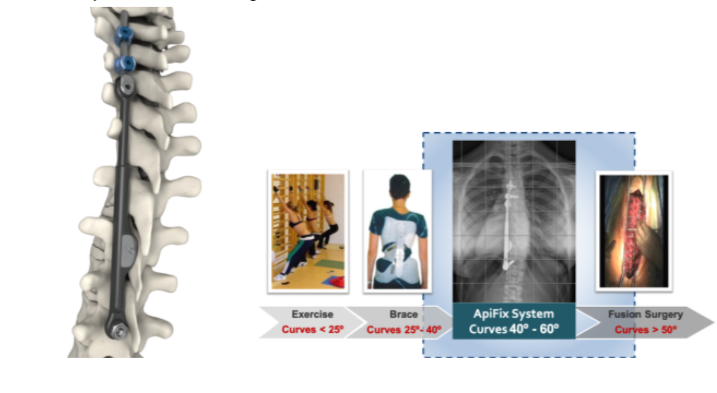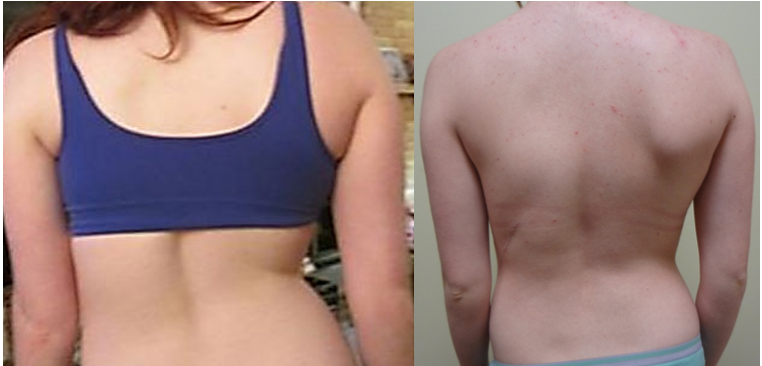Non-Fusion Corrective Scoliosis Surgery
Read below to find out more about current non-fusion scoliosis surgical options including Vertebral Body Tethering and ApiFix
Anterior Scoliosis Corrective Surgery (Also Known As “VBT”)
An exciting new approach to scoliosis is Anterior Scoliosis Corrective Surgery, otherwise known as VBT. This approach, begun nearly ten years ago, results in correction of progressive scoliosis and takes advantage of future growth to result in further correction of the scoliosis over time. This occurs through growth modulation in which the tethered side of the spine grows less than the non-tethered side. The advantage of this surgery is that it preserves growth, flexibility, and may result in continuous correction of the spine over time while not stiffening the spine. The Anterior Scoliosis Corrective Surgery is done through an anterior fusion approach and can be used to correct thoracic and thoracolumbar scoliosis.
Who is a candidate for this surgery?
The most common candidate for this procedure is a growing adolescent (age 10 and older) in whom further growth can be taken advantage of to get more correction of the curvature over time. Curvature between 40-70 degrees and in some cases, even larger, potentially can be treated with this technique. Indications have expanded to younger children as well as to those who have reached skeletal maturity (end of growth) and who would prefer to avoid a traditional fusion. Dr. Lonner and his team can discuss your particular case or that of your daughter or son to determine whether or not you are a candidate for Anterior Scoliosis Corrective Surgery.
How is Anterior Scoliosis Corrective Surgery performed?
The surgery is performed with a team that includes a general or thoracic surgeon and an assistant in addition to Dr. Lonner. Some patients have a thoracic curve, some a thoracolumbar curve, and some both which will determine whether one or two approaches are required. The incision for each curve is made on the patient’s side and is kept as small as possible. Usually, a scope (VATS) is used to improve visualization and access to the spine through a small incision called a portal.
Sometimes two portals are made in addition to the main small incision. These incisions are hidden by the arm and in the case of a young lady or girl, a bathing suit. The incisions are made in a way in which the muscles are not cut, so as to preserve strength and function and ease recovery. Through these incisions, titanium screws [which are coated with hydroxyapatite, the substance that bone is composed of and helps bone to grow into the screws from the vertebrae to strengthen the anchorage of the screw] are placed across the vertebrae at each level in which the spine is curved (see figures below). After the screws are placed and confirmed both by direct visualization and specialized x-ray, a flexible cord rod which is like a rope is attached to the screws and fixed by a set screw at each level after first tensioning the cord rod in order to get a correction of the curvature. After the tensioning has been completed, a final x-ray is done, a chest tube is placed to drain fluid and air, and closure of the incision is performed. An epidural catheter is placed for postoperative (after surgery) pain control. The chest tubes usually are removed within the first 2-3 days. The patient gets out of bed the day after surgery and is able to go home after 3-5 days. After 6 weeks, our patients are allowed to return to sports. The few weeks after surgery before return to full activity allows for bone to grow into the screws and to stabilize them.
Who should perform this procedure?
Candidates for Anterior Scoliosis Corrective Surgery should be cared for by a surgeon who has a great deal of experience in anterior fusion approaches. Dr. Lonner has been performing anterior approaches for the treatment of scoliosis for the past nearly 20 years. Dr. Lonner and his team welcome a visit with you to discuss your treatment.
*The implants used for performing Vertebral Body Tethering (VBT) is an unapproved new device that the U.S. Food and Drug Administration (FDA) has not cleared for marketing. We do not claim safety and efficacy for this procedure, which can only be determined by the FDA. Dr. Lonner discusses the risks and benefits that he believes to be associated with the use of the system in treating pediatric scoliosis as well as alternative treatment options for scoliosis with each and every patient he evaluates.
Anterior Scoliosis Corrective Surgery Resources
Patient Story 1
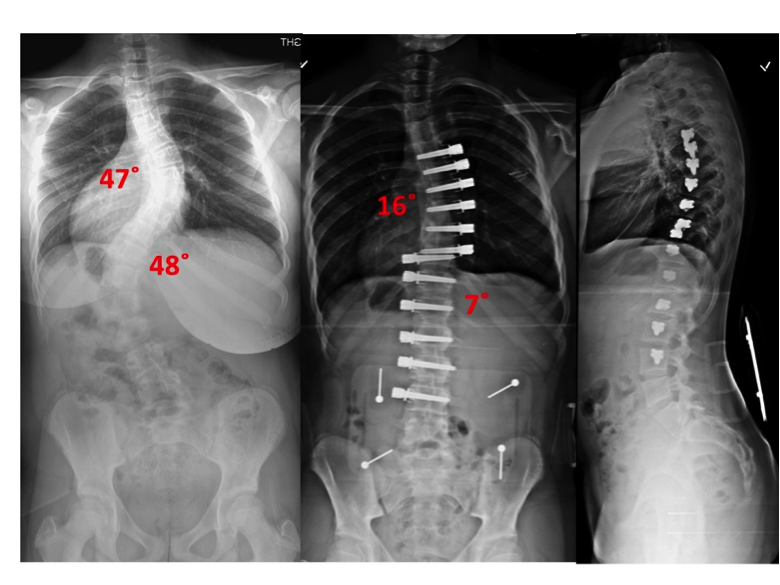
This 12½-year old girl is an avid basketball player and horseback rider. She underwent vertebral body tethering procedure (VBT), which was performed by Dr. Lonner, with excellent correction of her scoliosis. She was allowed to return to full activities 6 weeks following surgery. The video shows the patient bending 3 weeks after surgery.
Patient Story 2
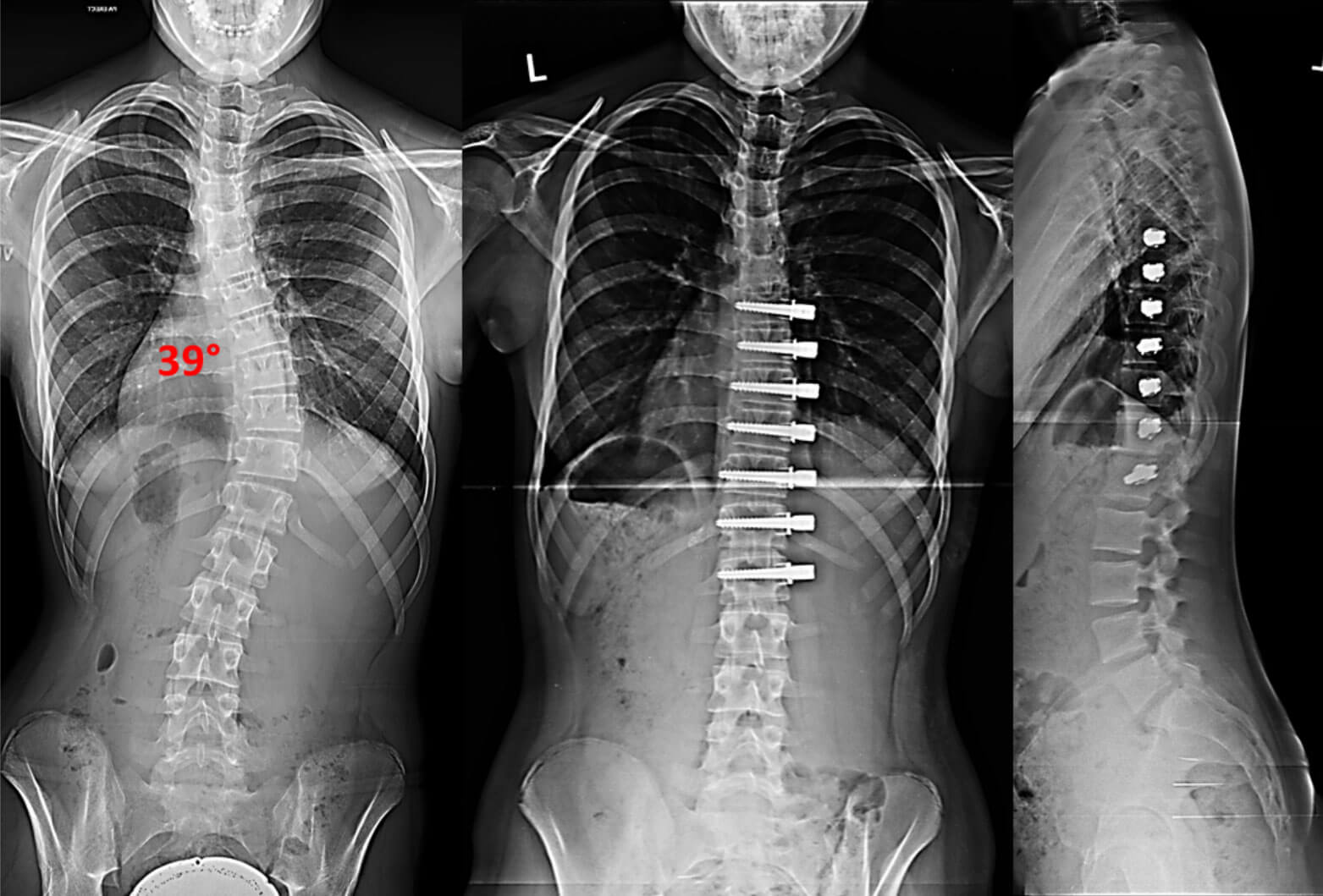
Emiline is a 14-year-old girl who came to see Dr. Lonner for worsening scoliosis. She was braced at the age of 13 and received chiropractic physical therapy which unfortunately did not prevent her curve from progressing. Emiline is an avid tennis player who is USTA junior ranked. Dr. Lonner performed a VBT procedure also known as tethering or flexible fusion.
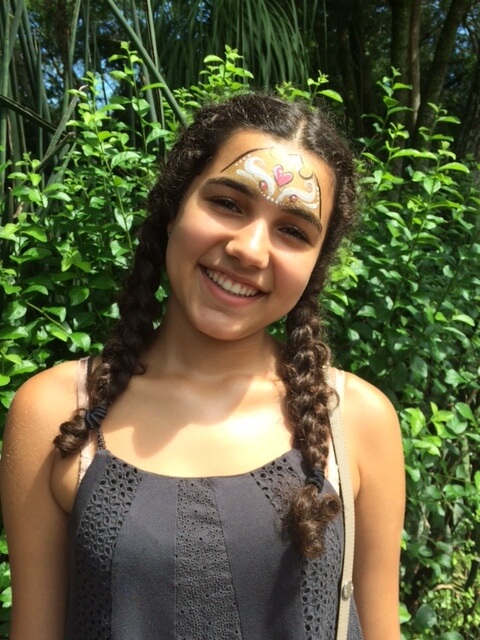
Emiline is doing very well since her surgery. Her curvature was 100% corrected. She began footwork drills at 4 weeks and rallying at 5 weeks after surgery.
Patient Story 3
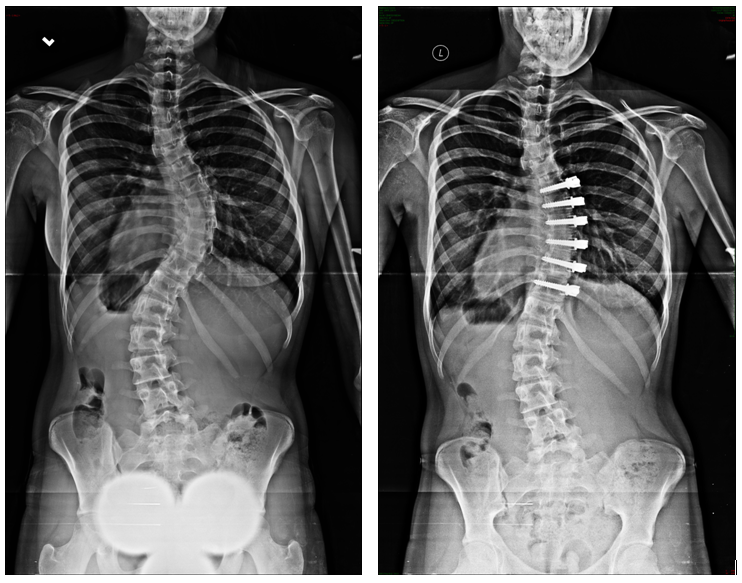
Shelby is a 16-year old girl from Minnesota. She came with her parents to see Dr. Lonner to learn about her options for correction of her scoliosis. Shelby had a severe and worsening idiopathic scoliosis with some back pain as well. Dr. Lonner performed VBT, anterior scoliosis correction for Shelby. Her 71° thoracolumbar curve is nearly 100% corrected after surgery. At 3-month post-surgery, she went back to her Tae Kwon Do practice. She also enjoys lifeguarding and went on a 2-week hiking trip in the Himalayas with her church youth group.
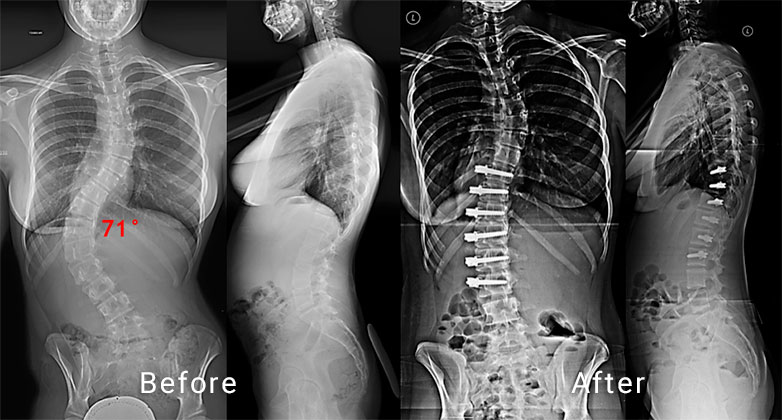
A Testimony from Shelby's mother - 5 weeks post-surgery:
"Today is 5 weeks post op already! We've had a pretty smooth recovery. She is eating and sleeping well, getting regular walks, regaining some weight now after losing about 10 pounds initially. Shelby walked about a mile and a half the day before we left along the East River walkway. She sang in church a week after getting back and has been attending her choir rehearsals.
We are very happy with our decision to work with you all. This has been a life changing event for Shelby. We look forward to sending you a picture when she gets her black belt in Tae Kwon Do (that will be a year or two, but whenever it is, you will be in our thoughts that day!)."
1-week pre-op 1-year post-op
A Testimony from Shelby's mother - 3 months post-surgery:
"To further update you on Shelby's recovery, her posture is much improved- her hips aligned and shoulders getting better weekly. She has some mild to moderate intermittent pain where the concave side of the curve was. I think that is fairly normal. Otherwise she feels great and looks great.
She is back to normal activity which means very busy and active. We could literally never have ended that video. Last night she passed her test for another belt in Tae Kwon Do. She will start lifeguarding in a few weeks and is getting ready for a 2-week trip hiking in the Himalayas with her church youth group in June. While she could possibly do all these things with a large lumbar curve, we know that the curve left untreated would keep progressing and the stress of an active life would mean quicker degeneration down the road. Same with fusion rods, and the added issue of lower mobility would almost certainly mean no lifeguarding, no Tae Kwon Do and no hiking trip. VBT surgery has changed the course of her life.
Thank you for all you have done for us."
Patient Story 5
Mya is 11 years old and a competitive dancer who trains 20 hours a week. She has been dancing since the age of 4 and has dreams of becoming a professional dancer. She has obtained many regional and national awards and scholarships—dance is her true passion.
Mya’s X- Rays
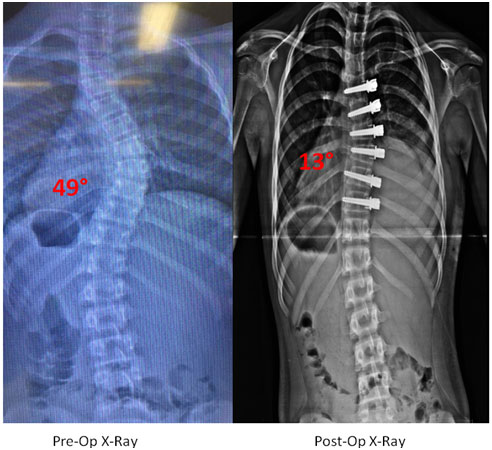
Through Anterior Scoliosis Correction, Dr. Lonner was able to correct Mya’s 49°
thoracic curve to 13°.
She is now back to dance with her flexible spine and it feels as if she has not even had surgery.
This is the first dance Mya rehearsed after her surgery. She was 7 weeks post op and feeling great!
ApiFix
A new approach to non-fusion scoliosis correction is termed posterior dynamic scoliosis correction using the ApiFix device which was FDA-approved in the United States in September of 2019. This device has been available to treat patients with adolescent idiopathic scoliosis in Europe and Israel for the past nearly one decade. Dr. Lonner has consulted with the ApiFix company and was instrumental in dealing with the FDA to help to bring this option to patients in the United States. https://apifix.com/
ApiFix is placed in patients through a posterior (back) approach, and it allows for correction of the spine without fusing the entire length of the curve as occurs in spinal fusion. There is some overlap in indications for VBT and ASC. Dr. Lonner and his team will discuss which option may be best for you based on your own preferences and ideal indications. Ideal candidates for ApiFix are adolescent patients with curves between 35 and 60 degrees and only a single curve. There is minimal blood loss and return to activities within 3-4 weeks. Patients who have failed bracing or who are unable to comply with bracing may be the best candidates for this procedure especially if they have further growth remaining and are likely to experience worsening of their curvature. The device is shown below.
